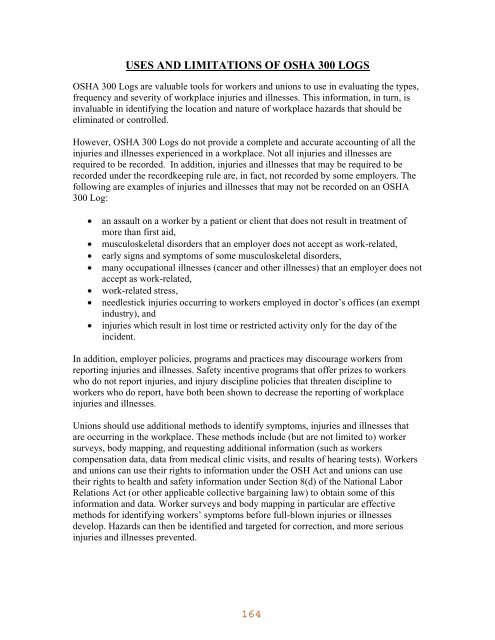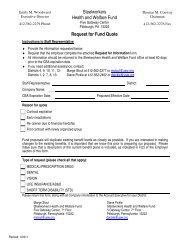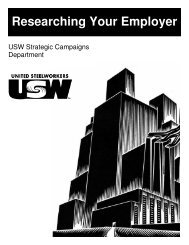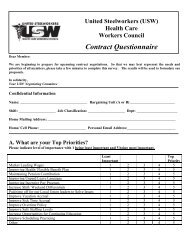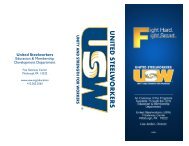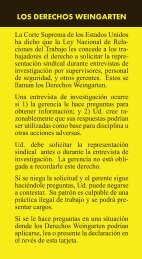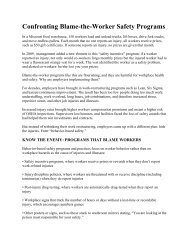Union Approach to Health and Safety: - United Steelworkers
Union Approach to Health and Safety: - United Steelworkers
Union Approach to Health and Safety: - United Steelworkers
Create successful ePaper yourself
Turn your PDF publications into a flip-book with our unique Google optimized e-Paper software.
USES AND LIMITATIONS OF OSHA 300 LOGS<br />
OSHA 300 Logs are valuable <strong>to</strong>ols for workers <strong>and</strong> unions <strong>to</strong> use in evaluating the types,<br />
frequency <strong>and</strong> severity of workplace injuries <strong>and</strong> illnesses. This information, in turn, is<br />
invaluable in identifying the location <strong>and</strong> nature of workplace hazards that should be<br />
eliminated or controlled.<br />
However, OSHA 300 Logs do not provide a complete <strong>and</strong> accurate accounting of all the<br />
injuries <strong>and</strong> illnesses experienced in a workplace. Not all injuries <strong>and</strong> illnesses are<br />
required <strong>to</strong> be recorded. In addition, injuries <strong>and</strong> illnesses that may be required <strong>to</strong> be<br />
recorded under the recordkeeping rule are, in fact, not recorded by some employers. The<br />
following are examples of injuries <strong>and</strong> illnesses that may not be recorded on an OSHA<br />
300 Log:<br />
<br />
<br />
<br />
<br />
<br />
<br />
<br />
an assault on a worker by a patient or client that does not result in treatment of<br />
more than first aid,<br />
musculoskeletal disorders that an employer does not accept as work-related,<br />
early signs <strong>and</strong> symp<strong>to</strong>ms of some musculoskeletal disorders,<br />
many occupational illnesses (cancer <strong>and</strong> other illnesses) that an employer does not<br />
accept as work-related,<br />
work-related stress,<br />
needlestick injuries occurring <strong>to</strong> workers employed in doc<strong>to</strong>r’s offices (an exempt<br />
industry), <strong>and</strong><br />
injuries which result in lost time or restricted activity only for the day of the<br />
incident.<br />
In addition, employer policies, programs <strong>and</strong> practices may discourage workers from<br />
reporting injuries <strong>and</strong> illnesses. <strong>Safety</strong> incentive programs that offer prizes <strong>to</strong> workers<br />
who do not report injuries, <strong>and</strong> injury discipline policies that threaten discipline <strong>to</strong><br />
workers who do report, have both been shown <strong>to</strong> decrease the reporting of workplace<br />
injuries <strong>and</strong> illnesses.<br />
<strong>Union</strong>s should use additional methods <strong>to</strong> identify symp<strong>to</strong>ms, injuries <strong>and</strong> illnesses that<br />
are occurring in the workplace. These methods include (but are not limited <strong>to</strong>) worker<br />
surveys, body mapping, <strong>and</strong> requesting additional information (such as workers<br />
compensation data, data from medical clinic visits, <strong>and</strong> results of hearing tests). Workers<br />
<strong>and</strong> unions can use their rights <strong>to</strong> information under the OSH Act <strong>and</strong> unions can use<br />
their rights <strong>to</strong> health <strong>and</strong> safety information under Section 8(d) of the National Labor<br />
Relations Act (or other applicable collective bargaining law) <strong>to</strong> obtain some of this<br />
information <strong>and</strong> data. Worker surveys <strong>and</strong> body mapping in particular are effective<br />
methods for identifying workers’ symp<strong>to</strong>ms before full-blown injuries or illnesses<br />
develop. Hazards can then be identified <strong>and</strong> targeted for correction, <strong>and</strong> more serious<br />
injuries <strong>and</strong> illnesses prevented.


